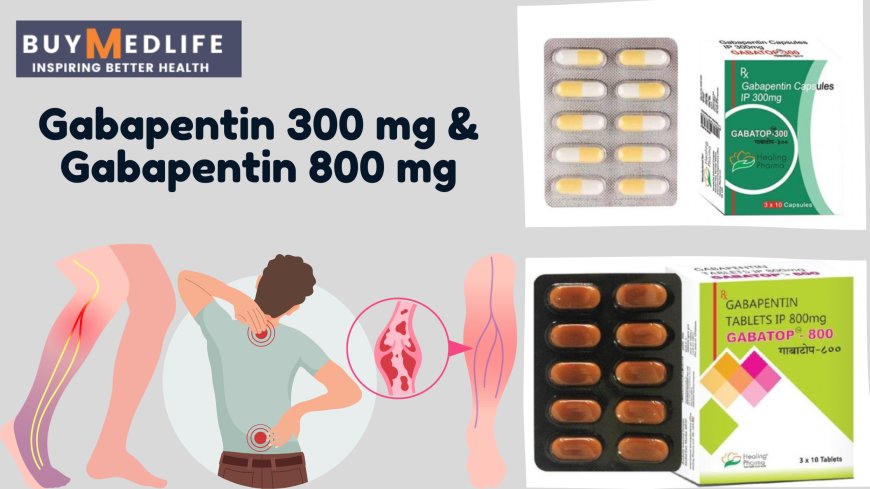Managing Neuropathy & Epilepsy with Gabapentin: 300 vs 800 mg
Gabapentin 300 mg vs 800 mg: Learn how both doses help manage neuropathy and epilepsy, and which might be best for your treatment needs.

Gabapentin is a widely prescribed medication for treating nerve-related disorders, especially neuropathy and epilepsy. Available in several strengths, the most commonly used are Gabapentin 300 mg and Gabapentin 800 mg. While both forms share the same active ingredient, the right dosage depends on the patients condition, response to treatment, and medical history.
In this article, well explore the roles of Gabapentin 300 mg and Gabapentin 800 mg in managing these conditions, their differences, and how healthcare providers determine the most effective dosage.
What Is Gabapentin?
Gabapentin is an anticonvulsant and nerve pain medication. It was initially developed to treat seizures but has become a go-to drug for neuropathic pain as well. It works by calming nerve activity in the brain and throughout the nervous system, helping to reduce symptoms like burning, tingling, and seizures.
Gabapentin for Neuropathy
Neuropathy is a condition caused by damaged or malfunctioning nerves, often linked to diabetes, shingles, or injuries. Gabapentin helps relieve the chronic pain and discomfort caused by overactive nerves.
-
Gabapentin 300 mg is often prescribed at the beginning of treatment. It's a safe, manageable starting point for new users and allows doctors to monitor side effects or initial reactions.
-
If symptoms persist or the patient doesnt respond well to the lower dose, Gabapentin 800 mg may be introduced gradually. It offers a more potent level of nerve pain relief, especially for those with chronic or advanced neuropathy.
Gabapentin for Epilepsy
Gabapentin is also approved as an adjunct therapy for partial seizures in adults and children over 3 years old. It doesn't replace primary seizure medications but adds support when one drug alone isnt enough.
-
Gabapentin 300 mg can be used as part of a combination therapy, especially in patients just starting antiepileptic treatment.
-
Gabapentin 800 mg is typically prescribed when seizure control requires higher doses, or when the patient has shown good tolerance to lower strengths.
For epilepsy, dosing frequency is critical. Gabapentin is usually taken 3 times a day, regardless of the strength, to maintain steady levels in the bloodstream.
Gabapentin 300 mg vs 800 mg: Key Differences
| Feature | Gabapentin 300 mg | Gabapentin 800 mg |
|---|---|---|
| Purpose | Starting dose for pain or epilepsy | Higher dose for persistent symptoms |
| Ideal For | New users, mild to moderate symptoms | Long-term use, severe symptoms |
| Tablet Size | Smaller, easier to swallow | Larger, may be split if needed |
| Common Usage | Initial treatment phase | Maintenance or escalated treatment |
| Risk of Side Effects | Lower | Higher, especially dizziness or fatigue |
Titration and Dose Adjustment
Doctors often start patients on Gabapentin 300 mg and gradually increase the dose based on response. This process is called titration. The goal is to reach a therapeutic level while minimizing side effects. If needed, the patient may be stepped up to Gabapentin 800 mg, especially if pain or seizures are not well controlled.
Never increase or decrease your dosage without a doctors supervision, as sudden changes can cause withdrawal symptoms or worsen your condition.
Side Effects to Watch For
Whether you're taking Gabapentin 300 mg or Gabapentin 800 mg, you may experience some common side effects:
-
Drowsiness
-
Dizziness
-
Fatigue
-
Coordination problems
-
Swelling in the extremities
These effects are usually mild but can become more pronounced at higher doses. Always report persistent or severe symptoms to your healthcare provider.
Which Dose Is Right for You?
Choosing between Gabapentin 300 mg and Gabapentin 800 mg depends on several factors:
-
Severity of your condition (neuropathy or epilepsy)
-
Response to lower doses
-
Tolerance to side effects
-
Other medications youre taking
-
Age and kidney function
Your doctor may conduct periodic evaluations to adjust your dose over time. Some patients stay on 300 mg successfully, while others need the extended relief that 800 mg provides.
Conclusion
Both Gabapentin 300 mg and Gabapentin 800 mg play vital roles in managing neuropathy and epilepsy. The lower dose is typically used to initiate treatment, while the higher dose provides more aggressive symptom control when needed. The key is individualized careworking with your doctor to find the safest, most effective dose for your specific needs.
If you're dealing with nerve pain or seizures, consult your healthcare provider about which Gabapentin dosage may work best for you.































